Abstract
The surface roughness, static and dynamic liquid wettability of modified poplar wood were measured by different surface treatment of brushing primer and sanding. With the increase of the number of grinding paper, the depth parameters Ra, Ry, Rz and Rp of surface roughness of modified poplar decreased, and the density parameter Sm (the average spacing of micro unevenness of contour) decreased at first and then increased. With the increase of number of the grinding paper, the contact angle of water and glycerol for modified poplar wood decreased at first and then increased. After the modified poplar wood was brushed with the primer and sanded with 240# sandpaper, the density parameter Sm was 0.307, the equilibrium contact angle of distilled water was 34.88, and the equilibrium contact angle of glycerin was 36.46, all of which were the lowest number. At this time, the surface roughness was improved, and the modified poplar has the good wettability that is greater than the mahogany wood wettability. Compared with mahogany, the rough depth parameters of the modified poplar are smaller to those of mahogany, but the Sm of modified poplar wood is greater than that of the mahogany. After the same surface pretreatment, the wetting speed of glycerol on the surface of mahogany is higher than that of the modified poplar.
1. Introduction
In European and American furniture, antique finishing process is a typical surface decoration technique, which gives furniture a sense of age through coloring with dyes or pigments and the adhesion of multiple layers of paint. If the wood surface is properly prepared, an excellent finishing effect can be obtained [1]. Wood surface treatment mainly includes sanding, wood wool removal, bleaching, sealing paint, and ash supplementation [2,3]. Wood wool removal is the process of removing wood hair from the surface of wood with sandpaper or iron emery cloth. Ash supplementation means filling holes, a construction process in which putty or hole filling material is scraped across the surface of the object [4]. Sanding can remove many kinds of traces and pollutants on the wood surface. Sanding materials mainly include sandpaper, abrasive belts, emery cloth, etc., which are the grinding tools with abrasives stuck on carriers [5]. Wood is a kind of natural porous material. The wood surface has a certain degree of unevenness, that is surface roughness, no matter how it is ground. If the surface of workpiece is too rough, the amount of sanding increases, the coating penetrates too much, and an unequal paint film easily forms after curing [6,7].
Sulaiman et al. [8] studied the effect of sanding on the surface roughness of rubberwood. The sessile water drop technique was used to determine the contact angle of the surface. The results indicated that the sanding process could improve the surface roughness. Lower grit size gave rougher surface. The sanding and coating processes of black alder wood were optimized by Salca [9]. It was found that the surface roughness of the sanded specimens and the power consumption during sanding strongly depends on the grit size used. The sanding with a grit sequence of 60, 120, and 150 grit size abrasives was found to be optimal when applied to black alder wood. Standard open-type sandpaper with different grit sizes to grind wood samples on the eccentric sanding stand was used to obtain different wood surface roughnesses on samples [10]. It was determined that with increasing grit size of the abrasive material, the roughness of wood surface decreases in all three measurement directions, but a linear dependence was not been established due to the microstructure features of wood.
Redzuan et al. [11] investigated the effects of surface treatment on the wettability of mangium wood. Two types of solvents, methanol and sodium hydroxide at different concentrations were used to treat the wood surface. The results showed that NaOH-treated surface had a relatively lower contact angle than methanol-treated wood. Based on both wettability and appearance, the best results were given by 6% methanol for sapwood and 4% methanol for heartwood. Blanchard et al. [12] examined the performance of selected coatings on wood pretreated with plasmas in a field test, and proved that plasma treatment of wood prior to coating could lead to improved coatings performance and resistance to mold or blue stain. Modified poplar, as a material modification of fast-growing poplar in plantations, is applied in mahogany wood furniture at present. Poplar wood is modified by physical, chemical or other methods to make it have better performance. This process is called “modification”, and poplar after modification is called “modified poplar”. For the strict technological requirements on external modeling and surface finishing, the use of modified poplar is still under experimental study. Especially in view of the extremely complex and important surface finishing process used in European and American furniture production, how to obtain qualified or even excellent coating effect on modified poplar wood is worthy of in-depth study [13,14,15,16]. The surface properties of common wood were systematically studied, and wood modification methods were effectively studied [17,18,19,20]. However, research on the surface properties of modified poplar, especially the influence of pretreatment on modified poplar, is rarely reported.
In this paper, focusing on the surface roughness of modified poplar after painting with primer, the difference of surface properties of modified poplar in pretreatment stage was compared and the influence of surface differentiation treatment on the surface roughness and wetting properties of modified poplar was explored.
2. Experiment
2.1. Materials
The main components of the Didebao primer are water, oil, resin, pigment, thinner, auxiliary materials (drier, curing agent, plasticizer and moisture-proof agent) provided by Mingshida Co., Ltd. (Taian, China). Modified poplar (Populus tomentosa Carr) (sawed transversely, size 150 mm × 80 mm × 20 mm, diameter section) was provided by Jiayue Wood Industry Co., Ltd. (Dezhou, China). The specific steps of poplar wood modification are as follows. First, urea was dissolved in water and antimony trioxide was dissolved in glacial acetic acid. The poplar wood modifying agent was prepared by mixing these two liquids. Then the poplar wood was processed into 150 mm × 80 mm × 20 mm pieces according to the requirements, and then put into the modifier (liquid) under vacuum, for 4 h under a pressure of 3.0 MPa. Finally, the poplar was sent to a 90 °C drying chamber for 24 h to reach an equilibrium moisture content of 8.0%. Mahogany (Swietenia macrophylla King) (size 150 mm × 80 mm × 20 mm, diameter section) was provided by Henghe Co., Ltd. (Zhangjiagang, China). The 180#, 240#, 320# and 400# wet/dry sandpapers were provided by Feili Co., Ltd. (Xianning, China). Two different trees were used in this work, namely modified poplar and mahogany. The materials used are 8-year-old modified poplar and 21-year-old mahogany. The trunk of the core material was selected. Sampling was conducted in Dezhou Jiayu Co., Ltd. (Dezhou, China) and only the heartwood was studied for both woods. The surfaces of poplar and mahogany are processed by the same mechanical processing and the same cutting method. The influence of the Didebao primer and sanding on the surface properties of the samples was investigated in this paper, so only the surface of the samples is sanded. Since the primer used in this experiment was Didebao primer, and the particles in Didebao primer were fixed rather than variable, the effect of surface roughness on wettability was mainly considered, regardless of the amount of influence of particles on wettability [21]. The wettability refers to the ability of a liquid to spread on the solid surface.
2.2. Preparation of Sample
Different pretreatment of sanding and brushing primer were mainly carried out. In this experiment, the first sanding after the modified poplar sawed into blocks was uniform. The modified poplar large plate is sanded by a wide band sander (120#), in which the wide side is sanded three times and the narrow side is sanded twice. Square oscillating sander (180#) was sanded for the four sides and four edges of modified poplar substrates. The surface of the samples (only modified poplar) was sanded with different sandpapers (180#, 240#, 320# and 400#, provided by Feili Co., Ltd.). Different treatments mainly reflected whether primer was applied and different numbers of sanding treatments (Table 1). Sample 1# is the modified poplar without any treatment, which is used as the original reference. Sample 2 was coated with 110.0 g/m2 of Didebao primer but not sanded, and Samples 3–6 were sanded with different number of sandpaper after brushing primer. Sample 7 was coated with 110.0 g/m2 of Didebao primer and sanded with 320# sandpaper. The primer was uniformly coated on the surface of the sample. When brushing, the sample was first brushed in parallel with the wood grain, and then the vertical texture was brushed again, so as to ensure that the coating was uniform and no parts were missed. After painting, the sample was put in a clean and ventilated indoor environment and dried naturally for about 24 h before proceeding to the next operation. When the primer was completely dried, the relevant samples were sanded. The samples are shown in Figure 1. In order to achieve uniform grinding, a square oscillating sander was used to grind with different numbers of sandpaper. When grinding, the operation was carried out four times perpendicular to the wood grain. Finally, the sawdust was sprayed away with a jet nozzle, and the surface was gently wiped clean with a cotton cloth. After standing for two days, the surface roughness was measured. The purpose of standing was to make the ground material surface have a self-adjusting process [22]. Mahogany is a common material used in European and American furniture manufacturing. Sample 7 was used as a comparative sample to compare the surface properties of modified poplar and mahogany wood after the same treatment.

Table 1.
Preparation of sample in pretreatment experiment stage.
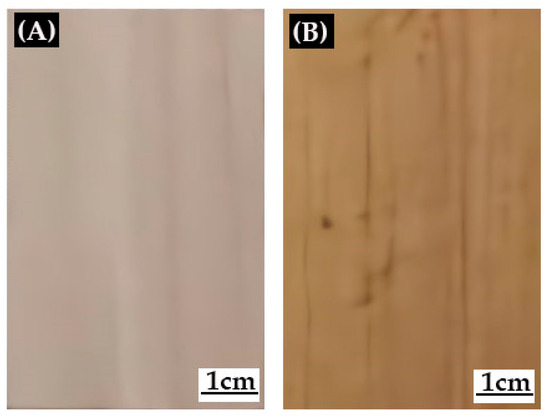
Figure 1.
Modified poplar (A) and poplar brushed Didebao prime (B) (specimen size 150 mm × 80 mm × 20 mm).
2.3. Testing and Characterization
The surface roughness of modified poplar after sanding with different types of sandpaper was tested with a SE1200 roughness measuring instrument (Zhipeng Instrument Trading Co., Ltd., Shanghai, China). The surface roughness measurement was performed according to GB-T 3505-2009 [5]. Ra is the contour arithmetic mean deviation, Ry is contour height, Rz is ten-point height of micro unevenness of outline, Rp is contour maximum peak height, Sm is the average spacing of micro unevenness of contour. The Ra, Ry, Rz, Rp are microscopic surface depth parameters, and Sm is microscopic surface compactness parameters. Five roughness parameters were measured for each sample, and each roughness parameter was measured four times. The measurement distance on the wood sample was 50 mm, that is, one measurement was taken every 50 mm. The roughness measuring instrument was calibrated before use. The instrument was in contact with the needle and slowly approached the surface of the wood. The measurement key was activated according to the instructions on the display of the instrument. The needle slided slowly perpendicular to the wood texture [23,24].
The precision contact angle measuring instrument (Swedish Attention Theta, provided by Baioulin Technology Co., Ltd., Sweden) was used to test the surface wetting of modified poplar after different sanding. Test liquids were distilled water and glycerin. The surface tension value of glycerin was 63.3 mN/m and the surface tension of water was 72 mN/m. In this experiment, the volume of distilled water was set to 3 μL, and the volume of glycerol was set to 5 μL [25,26]. The precise contact angle measurement was performed according to ISO15989-2007 [27]. Glycerin is a fatty alcohol that has the typical chemical activity of a fatty alcohol. At the same time, it is a polyhydric alcohol and is the simplest trihydric alcohol. Therefore, glycerol also has the properties of a polyhydric alcohol in addition to the common properties of fatty alcohols. Because water can easily volatilize during painting and when measuring the dynamic wetting angle, even if the dynamic wetting angle of water is measured, the data obtained is inaccurate and not for reference. Furthermore, the glycerol and water both contain hydroxyl groups and only tested the dynamic wettability of glycerin was tested. In order to study the dynamic wettability of the surface, a generalized model, namely the S/G model, is introduced:
In the formula, θ is the contact angle at time t; θi is the contact angle at which the droplet has just landed on the solid surface; θe is the contact angle at which the droplet reaches a stable state at a certain time; t is the wetting time; K is the constant of the contact angle change, also known as the diffusion and penetration rate. In a physical sense, K reflects the spreading and penetration rate of the liquid on the solid surface [28].
Standard deviation is the arithmetic square root of the arithmetic mean from the square of the mean. Standard deviation is often used in probability statistics as the measurement basis of statistical distribution degree, reflecting the degree of dispersion of a dataset. The average value and standard deviation were calculated. The standard deviation is calculated as follows:
where σ is the standard deviation, n is the total number of samples, and χi is the i-th data. χa is the average value. The measurement was repeated four times with an error within 5% using a new sample each time.
3. Results and Discussion
3.1. Effect of Different Sandpaper Types on Roughness
The density and moisture content of the studied wood species are 0.36 g/cm3, 18.5%, respectively. The data in Table 2 are presented as average value ± standard deviation. It can be seen that the standard deviation is in a small range, which has a large reference value. In Table 2, the Ra, Ry, Rz, and Rp all decrease as the size of sandpaper increases. With the increase of sandpaper type, the number of Sm tends to decrease first and then increase. Comparing sample 5 with sample 7, after brushed with primer and sanded with the same type of sandpaper, the number of Ra, Ry, Rz, Rp and Sm are significant different.

Table 2.
Surface roughness result.
The larger the sandpaper model, the smaller and denser the sand, the finer the grinding of the surface of the material, and the more sufficient it is to cut the wood fiber. Thus Ry, Rp and Rz are reduced. The reduction of these parameters will inevitably lead to the reduction of the number of Ra within the same sampling length.
The overall situation of the surface roughness of the material can be reflected more comprehensively by the number of Ra. The smaller the number of Ra, the smaller the roughness of the material. Therefore, for the modified poplar with primer, the larger the type of ground sandpaper, the smaller the roughness obtained on the surface. The number of Sm, which has a greater influence on the surface finish, appears at the lowest number when the number of sandpaper is 240#, which indicates that the average spacing of the microscopic unevenness of the surface of the modified poplar is the smallest and the surface is the densest.
Comparing sample 1 without the primer with the Sample 2 with the primer but not sanded, it can be seen that after the primer is painted, the modified poplar surface roughness parameters Ry, Rp, Rz all decreased, while number of Ra increased, and number of Sm decreased. The primer is a water-containing sealing paint. During the drying process, moisture will evaporate and be lost, which will cause the fibers on the wood surface to harden and warp, which increases the number of Ra. It shows that the surface of modified poplar becomes rougher after painting with primer, but primer can fill the gaps on the surface of the wood, so the Ry, Rz, Rp reflecting the microheight are reduced. It can be found that, whether it is the microscopic height parameters Ry, Rz, Rp or the overall roughness parameter Ra, the mahogany wood has larger values than the modified poplar, but the surface density parameter of Sm of the mahogany wood is smaller than that of the modified poplar. The reason may be that there is already a pre-cured layer on the surface of the modified poplar, and the gap between the wood fibers has been filled to some extent. In addition, brushing primer will make the gap between the wood fibers more supplementary, so after grinding with the same type of sandpaper, the roughness depth parameter and overall roughness of the modified poplar are smaller than that of the mahogany.
3.2. Effect of Different Sandpaper Types on Wettability
The contact angle data of distilled water on the material is shown in Table 3. The initial contact angle and equilibrium contact angle of distilled water are shown in Figure 2. The viscosity of glycerol is very large, so the time to reach equilibrium is relatively long. The initial contact angle of glycerol and the equilibrium contact angle are shown in Figure 3. Initial contact angle is the contact angle when the liquid just drops on the surface of the material. When the liquid drops on the surface of the material for a period of time, the contact angle tends to remain unchanged. The contact angle at this time is called the equilibrium contact angle. The contact angle drop rate is the difference of initial contact angle and final contact angle, and then divide by the initial contact angle [29,30,31].

Table 3.
Initial and equilibrium contact angles of distilled water and glycerin.
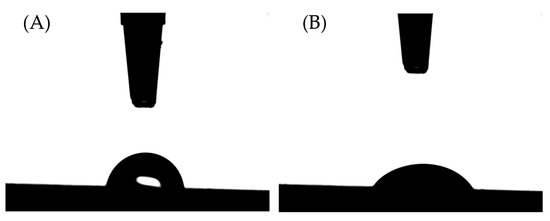
Figure 2.
Photograph of the initial (A) and equilibrium (B) contact angle of distilled water (Sample 4#).
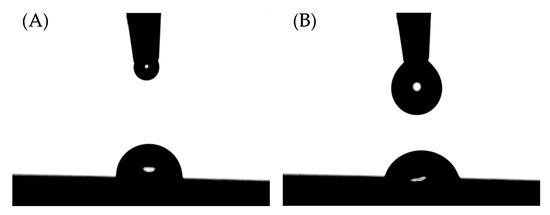
Figure 3.
Photograph of the initial (A) and equilibrium (B) contact angle of glycerin (Sample 4#).
From Table 3, due to its high viscosity, no matter what roughness it is on, or on untreated modified poplar and standard mahogany, the initial contact angle and equilibrium contact angle of glycerol are much larger than that of the distilled water. For the contact angle of distilled water, the initial contact angle is the largest for the Sample 6 which is the 400# sanded sample after painting primer, and the balanced contact angle is the largest for Sample 2 which has not been sanded after painting the primer. The reason for this phenomenon is that the sample 6 has the smallest roughness and relatively fine surface. When the distilled water is just in contact, the fine surface has better support for the water droplets, so the initial contact angle is the largest in the experiment. For the equilibrium contact angle, after the surface of the Sample 2 was coated with the primer, there was no grinding, and there was a dense coating on the surface, so the absorption of water was reduced, resulting in the largest equilibrium contact angle in the experiment.
The initial contact angle of glycerin is also the largest for Sample 6, and the equilibrium contact angle is the largest for Sample 2. For the Sample 1 without finishing primer, the contact angle of distilled water is very small compared with other samples. The effect of surface modified poplar on water absorption is very obvious, and it will cause the absorption of a large amount of paint which is not an optimistic thing. It can be seen that primer is very important for improving the surface properties of modified poplar. After proper sanding, the wettability is close to commonly used materials.
Both liquids reached the lowest initial contact angle and the lowest equilibrium contact angle on the Sample 4, which shows that the wettability of the modified poplar sample surface after being polished with 240# sandpaper and after finishing with primer was most prominent in the experiment. It can be inferred that as the surface roughness decreases, the wettability increases. After the roughness reaches a certain level, the wettability reaches the maximum, and then as the roughness decreases, the wettability continues to decrease. The reason is that after the modified poplar is ground by sandpaper with a larger sandpaper type, although the surface roughness becomes smaller, the density is not enough, the absorption capacity of distilled water and glycerin is large. With the further increase of the sandpaper type, the surface density and unevenness of the material are significantly improved, resulting in a weaker adsorption of the test liquid, thus showing the change trend of the contact angle in the chart. This trend is consistent with the change trend of the roughness parameter Sm, which also shows that the surface wettability of the modified poplar is closely related to the average pitch of the surface unevenness.
The contact angle of the liquid on the surface of the solid material is an important parameter to measure the wettability of the liquid on the surface of the material. The smaller the contact angle, the better the wettability, the easier the surface is to be wetted by the liquid, and the more favorable it is for the coating of the surface [32]. However, if the contact angle is too small, it will cause the surface to absorb too much paint, which is not conducive to surface finishing [33,34]. It can be seen from Figure 4 that the rate of decrease in contact angle reflects the degree of change in contact angle from the initial state to the equilibrium state, which characterizes the strength of the material surface’s ability to adsorb the liquid. The graph shows that the rate of contact angle decline of glycerol increases first and then decreases as the depth of the surface roughness decreases, and the modified wood’s adsorption strength of glycerin gradually increases and the equilibrium contact angle becomes smaller. When the adsorption strength of the modified poplar to glycerin weakens, the equilibrium contact angle gradually becomes larger.
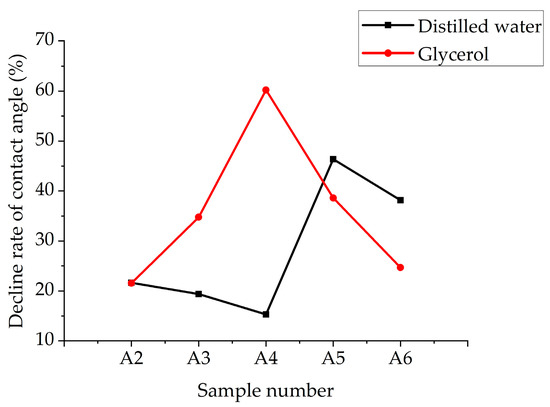
Figure 4.
Trend graph of the decline rate of contact angle between glycerin and distilled water.
However, this theory is not applicable to the trend of the decline rate of the contact angle of distilled water. The decline rate of the contact angle of distilled water in Figure 4 decreases first and then increases, reflecting that the adsorption capacity of the modified poplar is weak first and then strong. But from the change trend of the equilibrium contact angle of distilled water in Table 3, when the surface adsorption strength is large, the equilibrium contact angle also becomes larger. The stronger the adsorption of distilled water on the surface of the modified poplar is, the shorter the time for the distilled water to reach the equilibrium state, and the larger the contact angle is. This is the characteristic of reaching equilibrium state in a short time which is different from glycerol reaching equilibrium in a longer time.
In addition, from Figure 4, it can also be seen that the rate of decrease of the surface contact angle of distilled water and glycerin is approximately the same for Sample 2, which shows that for the modified poplar surface that has not been sanded by painting primer, the adsorption strength of liquids with different viscosities is the same. The surface wettability of modified poplar is less than that of mahogany. From this point, it shows that the modification of poplar, the treatment of primer is quite effective in sealing the gap of poplar.
3.3. Modified Poplar Surface Dynamic Wettability after Pretreatment
Regarding the determination of the number of K, the Origin software is used here to nonlinearly fit the data of the contact angle of glycerin at various times, so as to find the number of K. The fitting curve of the S/G model of Samples 1–7 is shown in Figure 5, Figure 6, Figure 7, Figure 8, Figure 9, Figure 10 and Figure 11. The figures involves the fitting of the S/G model curve of seven samples. In addition, the number and standard errors of K are shown in Table 4.
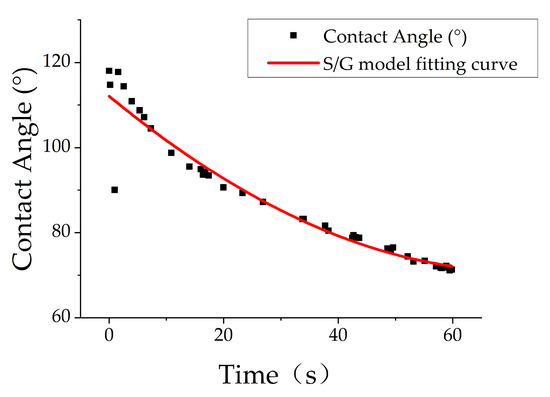
Figure 5.
S/G model fitting curve of glycerol contact angle (Sample 1).

Figure 6.
S/G model fitting curve of glycerol contact angle (Sample 2).

Figure 7.
S/G model fitting curve of glycerol contact angle (Sample 3).
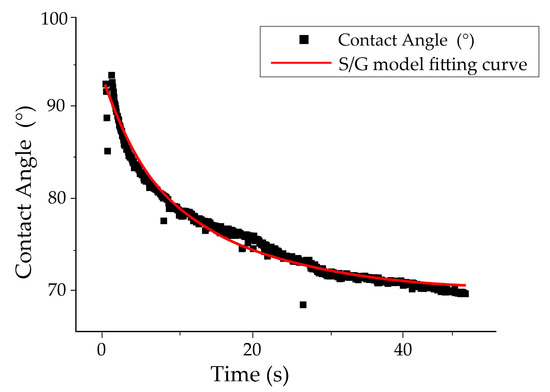
Figure 8.
S/G model fitting curve of glycerol contact angle (Sample 4).

Figure 9.
S/G model fitting curve of glycerol contact angle (Sample 5).

Figure 10.
S/G model fitting curve of glycerol contact angle (Sample 6).
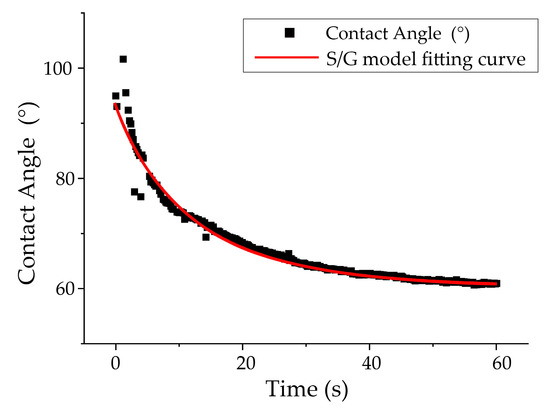
Figure 11.
S/G model fitting curve of glycerol contact angle (Sample 7).

Table 4.
K value of glycerin on the sample.
The number is calculated by the software after simulation and can be directly used as the reference number of the liquid penetration rate. When performing curve fitting, the S/G model must first be written and imported in the software according to the difference of each group of experiments. After the test is available, all the contact angle data obtained by the previous measurement are imported into the software table. It can be seen from Table 4 that the number of K of Sample 2 is greater than that of Sample 1, but smaller than that of Sample 3, and the number of K of Samples 3–6 shows a trend of decreasing sequentially. This illustrates the following problems: when the modified poplar is painted with primer, the wetting speed of glycerol becomes larger, which may be due to that both primer and glycerin are polar molecules. After finishing the primer, 180# sandpaper is used for sanding, and the wetting speed of glycerin becomes larger.
This is because the sanding with 180# sandpaper makes the modified poplar obtain a smoother surface, but the micro-density is not enough to make the wetting speed smaller, but the area of the contact angle between primer and glycerol is increased, making the wetting speed larger. The changed number of K of the Samples 3 and 4 shows that with the increase of sandpaper number, the surface roughness of modified poplar and the wetting speed of glycerol are continuously decreasing. Therefore, the contact area of primer and the surface roughness of modified poplar are the factors affecting the two key factors of the wet speed and they are both positively correlated. The results show that the glycerin wetting rate of the commonly used mahogany wood is greater than that of modified poplar, which is due to the rough surface of Sample 7 is greater than the surface roughness of Sample 5.
4. Conclusions
With the increase of grinding sandpaper model, the depth parameters Ra, Ry, Rz, Rp of the surface roughness of modified poplar showed a decreasing trend, and the compactness parameter Sm showed a trend of decreasing first and then increasing. The larger the sandpaper number, the greater the smoothness of the wood surface. The flattening of the surface of the modified poplar required the reduction of the depth of the roughness and the increase of the density. The modified poplar had the highest surface density after sanded with 240# sandpaper. With the increase in the size of grinding sandpaper, the contact angle of water and glycerin showed a trend of decreasing first and then increasing, which was consistent with the change trend of the surface roughness density parameter Sm of modified poplar. The minimum number was obtained when Sm = 0.307 μm, indicating that the denseness contributes to the improvement of the degree of wetting. The degree of wetting of distilled water was inversely related to the rate of contact angle decrease, and the degree of wetting of glycerin was positively related to the rate of contact angle decrease. With the increase of grinding sandpaper model, the glycerin wetting speed showed a decreasing trend. Compared with the standard material mahogany, after the same surface pretreatment, the wetting speed of glycerin was higher than that of modified poplar. After treated with the Didebao primer and 240# sandpaper, the wettability of the modified poplar was close to or even higher than that of European and American furniture wood. The result provides a technical reference for the application of modified poplar in European and American furniture materials.
Author Contributions
Conceptualization, Methodology, Validation, Resources, Data Curation, Writing—Original Draft Preparation, Q.L.; Data Analysis, D.G.; Investigation, Writing—Review and Editing, Supervision, W.X. All authors have read and agreed to the published version of the manuscript.
Funding
This research was funded by the General Program of Jiangsu Natural Science Foundation in 2020 (Project title: Study on the relationship between microstructure control of self-repairing coating and wood based on microcapsule technology).
Conflicts of Interest
The authors declare no conflict of interest.
References
- Yan, X.X.; Wang, L.; Qian, X.Y. Influence of the PVC of glass fiber powder on the properties of a thermochromic waterborne coating for Chinese Fir boards. Coatings 2020, 10, 588. [Google Scholar] [CrossRef]
- Yan, X.X.; Chang, Y.J.; Qian, X.Y. The properties of an aluminum/UV-curable, infrared, low-emissivity coating modified by nano-silica slurry. Coatings 2020, 10, 382. [Google Scholar] [CrossRef]
- Yan, X.X.; Chang, Y.J. Investigation of the properties of color-changing powder water-based coating. Coatings 2020, 10, 815. [Google Scholar] [CrossRef]
- QB/T 4461-2013 Technical Requirements of Surface Painting of Wooden Furniture; Ministry of Industry and Information Technology of the People’s Republic of China: Beijing, China, 2013. (In Chinese)
- GB/T 3505-2009 Geometrical Product Specifications (GPS)—Surface Texture: Profile Method—Terms, Definitions and Surface Texture Parameters; Standardization Administration of the People’s Republic of China: Beijing, China, 2009. (In Chinese)
- Yan, X.X.; Wang, L.; Qian, X.Y. Effect of coating process on performance of reversible thermochromic waterborne coatings for Chinese Fir. Coatings 2020, 10, 223. [Google Scholar] [CrossRef]
- Yan, X.X.; Wang, L.; Qian, X.Y. Preparation and characterization of low infrared emissive aluminum/waterborne acrylic coatings. Coatings 2020, 10, 35. [Google Scholar] [CrossRef]
- Sulaiman, O.; Hashima, R.; Subari, K.; Liang, C.K. Effect of sanding on surface roughness of rubberwood. J. Mater. Process. Technol. 2009, 209, 3949–3955. [Google Scholar] [CrossRef]
- Salca, E.A.; Krystofiak, T.; Lis, B. Evaluation of selected properties of alder wood as functions of sanding and coating. Coatings 2017, 7, 176. [Google Scholar] [CrossRef]
- Vitosyte, J.; Ukvalbergiene, K.; Keturakis, G. Wood surface roughness: An impact of wood species, grain direction and grit size. Mater. Sci. Medzg. 2015, 21, 255–259. [Google Scholar] [CrossRef]
- Redzuan, M.S.J.; Paridah, M.T.; Anwar, U.M.W.; Juliana, A.H.; Lee, S.H.; Norwahyuni, M.Y. Effects of surface pretreatment on wettability of acacia mangium wood. J. Trop. For. Sci. 2019, 31, 249–258. [Google Scholar] [CrossRef]
- Blanchard, V.; Stirling, R. Technical note: Plasma pretreatment enhances field performance of exterior wood coatings. Wood Fiber. Sci. 2013, 45, 228–231. [Google Scholar]
- Yan, X.X. Effect of different color paste on properties of fluorine resin/aluminum infrared low emissivity coating. Coatings 2020, 10, 70. [Google Scholar] [CrossRef]
- Yan, X.X.; Chang, Y.J. Investigation of waterborne thermochromic topcoat film with color-changing microcapsules on Chinese fir surface. Prog. Org. Coat. 2019, 136, 105262. [Google Scholar] [CrossRef]
- Canagaratna, M.R.; Massoli, P.; Browne, E.C.; Franklin, J.P.; Wilson, K.R.; Onasch, T.B.; Kirchstetter, T.W.; Fortner, E.C.; Kolb, C.E.; Jayne, J.T.; et al. Chemical compositions of black carbon particle cores and coatings via soot particle aerosol mass spectrometry with photoionization and electron ionization. J. Phys. Chem. A 2015, 119, 4589–4590. [Google Scholar] [CrossRef] [PubMed]
- Dong, H.L.; Wang, J.C.; Zeng, Y.R.; Chen, Z.S.; Shi, J.M. Reflection spectrum study of THz wave by infrared low emissivity stealth coating. Spectrosc. Spect. Anal. 2019, 39, 3007–3012. [Google Scholar]
- Yan, X.X.; Chang, Y.J.; Qian, X.Y. Effect of concentration of thermochromic ink on performance of waterborne finish films for the surface of Cunninghamia Lanceolata. Polymers 2020, 12, 552. [Google Scholar] [CrossRef]
- Yan, X.X.; Chang, Y.J. Effect of MF-coated epoxy resin microcapsules on properties of waterborne wood coating on Basswood. Coatings 2020, 10, 785. [Google Scholar] [CrossRef]
- Chang, Y.J.; Yan, X.X. Preparation and self-repairing properties of MF-coated shellac water-based microcapsules. Coatings 2020, 10, 778. [Google Scholar] [CrossRef]
- Yan, X.X.; Peng, W.W. Preparation of microcapsules of urea formaldehyde resin coated waterborne coatings and their effect on properties of wood crackle coating. Coatings 2020, 10, 764. [Google Scholar] [CrossRef]
- Meijer, M.; Haemers, S.; Cobben, W.; Militz, H. Surface energy determinations of wood: Comparison of methods and wood species. Langmuir 2000, 16, 9352–9359. [Google Scholar] [CrossRef]
- De Moura, L.F.; Hernandez, R.E. Effects of abrasive mineral, grit size and feed speed on the quality of sanded surfaces of sugar maple wood. Wood Sci. Technol. 2006, 40, 517–530. [Google Scholar] [CrossRef]
- Bao, X.; Ying, J.H.; Cheng, F.; Zhang, J.; Luo, B.; Li, L.; Liu, H.G. Research on neural network model of surface roughness in belt sanding process for Pinus koraiensis. Measurement 2018, 115, 11–18. [Google Scholar] [CrossRef]
- Gurau, L.; Mansfield-Williams, H.; Irle, M. Separation of processing roughness from anatomical irregularities and fuzziness to evaluate the effect of grit size on sanded European oak. For. Prod. J. 2007, 57, 110–115. [Google Scholar]
- Qin, Z.Y.; Zhang, Q.; Gao, Q.; Zhang, S.F.; Li, J.Z. Wettability of sanded and aged fast-growing poplar wood surfaces: II. dynamic wetting models. Bioresources 2014, 9, 7176–7188. [Google Scholar] [CrossRef]
- Gupta, R.; Mohanty, K.K. Wettability alteration mechanism for oil recovery from fractured carbonate rocks. Transp. Porous Media 2011, 87, 635–652. [Google Scholar] [CrossRef]
- ISO 15989-2004 Plastics-Film and sheeting-Measurement of Water-Contact Angle of Corona-Treated Films: Technical Committee ISO/TC 61, Plastics, Subcommittee SC 11; Products: Bern, Switzerland, 2004.
- Lam, C.N.C.; Ko, L.H.Y.; Yu, L.M.Y.; Ng, A.; Li, D.; Hair, M.L.; Neumann, A.W. Dynamic cycling contact angle measurements: Study of advancing and receding contact angles. J. Colloid Interf. Sci. 2001, 243, 208–218. [Google Scholar] [CrossRef]
- Moghaddam, M.S.; Walinder, M.E.P.; Claesson, P.M.; Swerin, A. Wettability and swelling of acetylated and furfurylated wood analyzed by multicycle Wilhelmy plate method. Holzforschung 2016, 70, 69–77. [Google Scholar] [CrossRef]
- Lam, C.N.C.; Kim, N.; Hui, D.; Kwok, D.Y.; Hair, M.L.; Neumann, A.W. The effect of liquid properties to contact angle hysteresis. Colloids Surf. A 2001, 189, 265–278. [Google Scholar] [CrossRef]
- Laskowska, A.; Kozakiewicz, P. Surface wettability of wood species from tropical and temperate zones by polar and dispersive liquids. Drvna Industrija. 2017, 68, 299–306. [Google Scholar] [CrossRef]
- Yan, X.X.; Wang, L.; Qian, X.Y. Effect of microcapsules with different core-wall ratios on properties of waterborne primer coating for European Linden. Coatings 2020, 10, 826. [Google Scholar] [CrossRef]
- Liptakova, E.; Kudela, J.; Bastl, Z.; Spirovova, I. Influence of mechanical surface-treatment of wood on the wetting process. Holzforschung 1995, 49, 369–375. [Google Scholar] [CrossRef]
- Santoni, I.; Pizzo, B. Effect of surface conditions related to machining and air exposure on wettability of different Mediterranean wood species. Int. J. Adhes. Adhes. 2011, 31, 743–753. [Google Scholar] [CrossRef]
© 2020 by the authors. Licensee MDPI, Basel, Switzerland. This article is an open access article distributed under the terms and conditions of the Creative Commons Attribution (CC BY) license (http://creativecommons.org/licenses/by/4.0/).